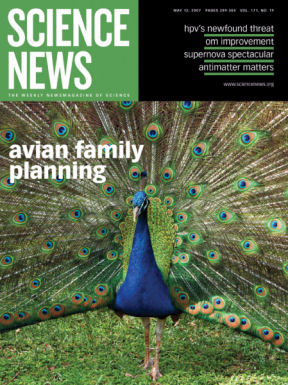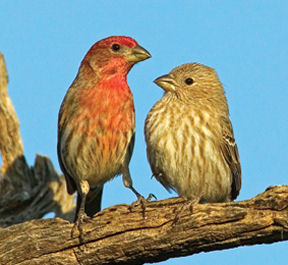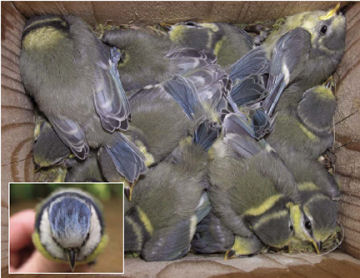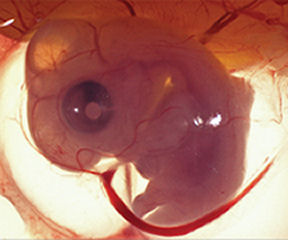In 1939, a man walking his dog in Brooklyn noticed Hollywood finches for sale in a store. The reddish-brownish seed eaters are native to the dry Southwest, including Southern California. A 1918 law was supposed to have protected such North American migratory birds from capture and sale as caged birds—though the rule was seldom enforced. The dog walker complained to authorities, and this time they began a crackdown. When some store owners around the city realized that they would get in trouble, they opened the cages and let the evidence fly away.




The odds would seem to be against desert birds from the other side of the continent surviving in New York City, but the finches settled into Central Park. From there, the population spread to New Jersey, and then—watch out, world.
During the next 60 years, what are now called house finches (Carpodacus mexicanus) moved into all the other lower-48 states and beyond. They now thrive in places as different climatically as Ontario and Florida. With such extreme adaptability, they’re “like birds made of interchangeable plastic parts,” says Alex Badyaev of the University of Arizona in Tucson.
One of the differences that Badyaev has observed among the widely scattered house finches shows up in their egg laying. The order in which mothers lay eggs containing male and female embryos isn’t random, he finds.
Other birds also have ways of beating the offspring-sex odds. Species as diverse as gulls and peacocks have been reported as boosting or shrinking the ratios of sons to daughters.
Badyaev’s work and other studies are exploring how a species might benefit from such skews. Among their ideas: Fixing the odds on offspring makes the best of ups or downs in Mom’s health, Dad’s sex appeal, and the quirks of the neighborhood. Scientists are now beginning to attack the looming question of what mechanism triggers such biases.
To mom’s health
From a mammal’s point of view, birds determine sex backwards. From apes to zebras, two copies of the X version of the sex-determining chromosome yield a female, and a mismatched pair, XY, makes a male. In birds, though, the pair of similar chromosomes, called ZZ, makes the sperm-producing male. The egg-laying female carries the mismatched ZW. So, it’s Mom’s genetic contribution that determines a chick’s sex.
Toward the end of the 1990s, researchers worked out sets of genetic markers that would identify a bird’s sex. With them, researchers could figure out the sex of eggs that didn’t hatch and of chicks that died before any revealing characteristic emerged. These techniques inspired research teams to test a decades-old prediction that a mother’s physical condition, be it robust or pathetic, leads her to produce more of one sex of offspring than the other.
“Peacock farmers say there’s a tendency for daughters to increase throughout the season,” says Thomas W. Pike, now at University of Glasgow in Scotland. This observation would fit the biologists’ theory if the later hatchings came from mothers worn out as the egg-laying season drags on.
Pike spent two summers on a peacock farm testing ideas about sex-ratio bias. The farmer wouldn’t permit experiments that would turn female birds into scrawny wrecks. So, Pike and Marion Petrie of the University of Newcastle upon Tyne in England took advantage of natural variations among birds.
The researchers penned each of six males with three females of different conditions, from thriving to weak. The males mated with them all. The proportion of daughters in the resulting clutches ranged from 25 percent to 87 percent. As predicted, the least robust females had the largest proportion of daughters, and the most robust females had the smallest proportion.
Why might it be advantageous for a sickly mother to have lots of daughters when sons—by fertilizing many females—could give her a bonanza of grandchildren?
For peacocks, as for many birds, only spectacular sons succeed, and a weak mother is unlikely to produce such champs. Males that rank ho-hum or worse can end up siring no grandchildren for Mom. Although daughters won’t give their mothers a bonanza of descendants, mediocre daughters have a better chance than mediocre sons do of raising at least a few chicks.
In the first test of this idea in the wild, scientists provided meals on wheels to lesser black-backed gulls (Larus fuscus). Ruedi Nager, of the University of Glasgow, and his colleagues delivered cooked chicken egg to some of the females every night starting 3 weeks before they started laying eggs and continuing until they finished. The females that had received the supplemental meals went into motherhood in top condition. Researchers stressed the females by tricking them into laying extra eggs.
Among the first eggs laid by all the females in the experiment, the sex ratio was roughly 50:50, as determined by blood tests on chicks at hatching. The well-fed birds kept that ratio of the sexes in the eggs that they laid later. But the other birds began producing more daughters, which survived better than sons did. By the 15th egg, almost three-quarters of the offspring from the unsupplemented group were female. The difference between the nutritionally challenged and the supplemented groups supports the view that physically stressed moms have more daughters, Nager’s group concluded.
Flashy dads
It’s not all about the moms, though. One of the early experiments on the influence of dads was inspired by a setback in establishing a lab colony of zebra finches. Nancy Burley, now of the University of California, Irvine, had found that the color of the leg bands she’d used to identify her birds could enhance or cut their chances of attracting a mate.
In 1981, Burley reported that dads sporting glamorizing red bands fathered chicks with a higher-than-average chance of being male. A dad rendered undesirable by an ugly green band tended to have extra daughters. One interpretation of the results is that if Dad is obviously sexy, then he’s a good bet for siring a son that will provide a grandchild bonanza.
Some other studies haven’t shown the same effect. For example, Alison N. Rutstein of the University of New South Wales in Sydney, Australia, and her colleagues reported in 2005 that, using variations on Burley’s protocols, they found no correlation between a dad’s sex appeal and a nest’s male-to-female egg ratio.
For studying the power of handsome fathers, what better birds to test than peacocks? Males don’t share the care of the chicks, so the females “use them only for their sperm,” says Pike.
To reversibly sabotage sex appeal, Pike cut 20 of the 120-to-200 tail feathers of each of 14 males, leaving the stubs of the feather shafts in place. To restore a male’s appeal for half the season, Pike later reattached the feathers.
When males could flaunt all their feathers, their proportion of sons ran 47 to 57 percent. When displaying tattered tails, males fathered only 28 to 35 percent sons.
Another species that’s starred in several studies of male charisma and sex ratio is the blue tit (Cyanistes caeruleus). The crests of the males look blue to human eyes but flash ultraviolet (UV) to other birds. Females prefer males that are UV bright. In studies of a male’s appeal, scientists have smeared some tit crests with a sun-blocking chemical.
The first crest-masking test to look at sex ratios in the wild came from Ben Sheldon at Oxford University in England and his colleagues in 1999. Obscuring the UV reflections of blue tits with particularly flashy crests produced extra daughters. But a group with superior crests unaltered by the researchers fathered plenty of sons. The difference supports the idea that more attractiveness in males yields extra sons, Sheldon concluded. More recently, Peter Korsten of the University of Groningen in the Netherlands repeated Sheldon’s study but ran it twice as long. Korsten and his colleagues observed the effect that Sheldon had noted, but only during the second year, the team reported in the July/August 2006 Behavioral Ecology. And males that had dull crests to begin with showed a hard-to-explain increase in sons after their UV-blocking treatment.
No effect of crest-UV reflection showed up in sex ratios in a 2005 study of blue tits by Amelie Dreiss of Pierre and Marie Curie University in Paris and her colleagues.
Dreiss says that studies haven’t addressed many factors that may influence egg laying. “[Crest] color may not have the same attractiveness in different populations because of the light environment,” she says. Also, the birds’ ages and ratios of males to females in an overall population may have an influence.
Territory effect has been considered in studies of a Seychelles warbler (Acrocephalus sechellensis) that’s found on only a few islands in the Indian Ocean. These birds typically produce a single egg in each round of nesting. Youngsters, especially daughters, linger in their parents’ territory and help feed chicks from later nests.
In a test of females that had no helpers, within territories buzzing and crawling with insects to eat, 87 percent of the chicks were female, Jan Komdeur of the University of Groningen reported in 1997. Within insect-poor territories, only 23 percent were daughters.
Komdeur then switched nestlings between good and lousy territories. Daughters in poor territories invited disaster, he found. Because they hung around, they ended up eating more than they were worth and reduced the parents’ chances of raising future chicks. Yet in good territories, extra daughters strengthened the parents’ chances of raising later offspring.
Order, order
Badyaev has looked beyond ratios of daughters to sons and considered their positions in families. He and his collaborators have been watching the house finch populations that moved into Alabama and Montana 20 to 30 years ago.
Among the differences between finches in the two states is the egg-laying order of the sexes. The first egg that a Montanan finch lays holds a male embryo about a quarter of the time. In Alabama, roughly two-thirds of the first eggs hold males.
By the last egg in the typical clutch of five, the slant reverses: more than three-quarters male in Montana and about a third in Alabama.
So do those quirks make any difference? The researchers tracked survival of the chicks by sex and by position in the laying sequence. In Montana, female chicks from the first egg had double the survival rate of male first-egg chicks. That skew fit the trend in sex bias: First eggs in Montana often held female chicks.
The other survival trends of first and last eggs likewise matched the sex bias for the location. Somehow, finches skewed the sex of their eggs for greater chick survival. Badyaev calculates that this pattern cuts chick death some 10 to 20 percent from what it would be if birds produced sons and daughters in a 50:50 ratio.
He wondered whether the laying order itself caused the effect. Or did the differences come from the hard scrabble world of the nest, where the last-laid chick struggles out of its egg to find a miniflock of older and larger siblings already competing for food?
To separate the effects, the researchers switched newly hatched chicks among nests. Some chicks were exchanged between nests where the females had started laying eggs at the same time, and so the transplanted chicks kept their original sibling ranks. However, the researchers also chose nests where the mothers had started laying eggs at different times. There, the transplants took the place of youngsters that had hatched in a different family position.
Badyaev and his colleagues conclude that what they see is not just an effect of sharing a nest with bigger or smaller chicks. The order in which the eggs were laid itself has an effect, though the result is different between the sexes and in different places.
The team then discovered a similar sex-skewing trick in the birds’ native range. Around Tucson, house finches breed twice a year. In late winter, they lay roughly half sons throughout the sequence of egg laying. In late spring, more than 80 percent of the last eggs in the sequence hold male embryos. Chick-survival trends work that way, too, favoring late females in fall and late males in spring.
What drives the change, Badyaev proposes, are blood-sucking mites. In the absence of mites, male chicks tend to do best when they hatch early with plenty of time to grow in the nest. However, “male nestlings have no tolerance for mites,” he says.
The pests are scarce in late winter, but by late spring, nests are crawling with mites. At that time, the males’ best bet is to hatch late and grow fast, the Badyaev group said in the Sept. 26, 2006 Proceedings of the National Academy of Sciences.
How to
These reports all raise the question of how birds might skew the sex ratio of their offspring. “We really don’t know,” says Hubert Schwabl, now of the Washington State University in Pullman. However, something he discovered in the early 1990s has been giving people ideas.
Schwabl startled ornithologists by finding a hormone, testosterone, in canary eggs. The later an egg fell in the laying sequence, the more concentrated the testosterone was. That pattern held regardless of the sex of the embryo, Schwabl reported.
Since then, researchers have found that eggs are loaded with hormones and other factors that affect a chick’s development and later characteristics.
After hormones were discovered in eggs, scientists became interested in possible effects of mothers’ hormones on eggs. Among the many ideas was a suggestion that a female bird’s hormones influence sex determination.
The idea isn’t easy to test directly, but in 2005, Stephanie M. Correa of Cornell University and her colleagues reported that hens injected with high concentrations of progesterone, one of the female reproductive hormones, laid eggs with female embryos 75 percent of the time, as compared with 37 percent among hens not getting the hormone shots.
Pike and Petrie tested various other hormone implants in captive Japanese quail. Females dosed with extra corticosterone, a hormone that spikes during stress, laid eggs with female embryos almost 70 percent of the time, as compared with 45 to 50 percent among other females’ nests, the researchers reported in the May 7, 2006 Proceedings of the Royal Society B.
However the sex biases happen, they represent a legacy from the mother that goes beyond classical genetics. “The biggest challenge,” says Badyaev, “is to figure out the place of such maternal effects in the grand scheme of evolutionary processes.”





